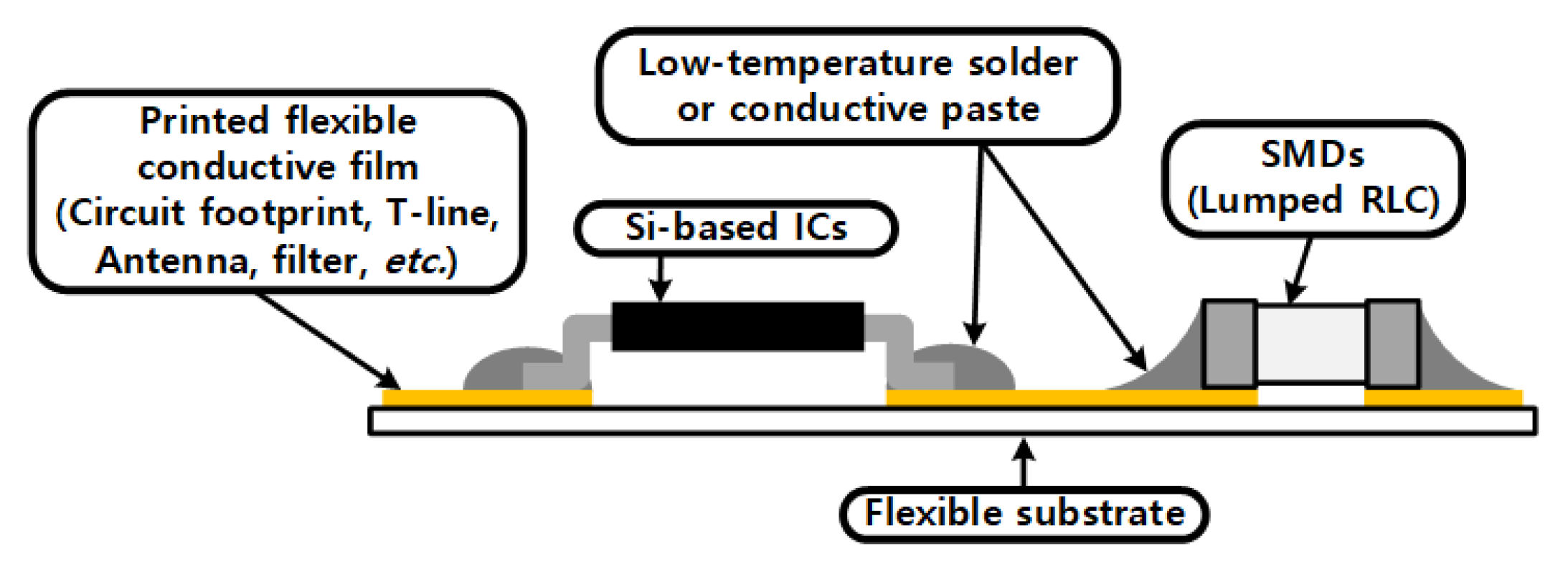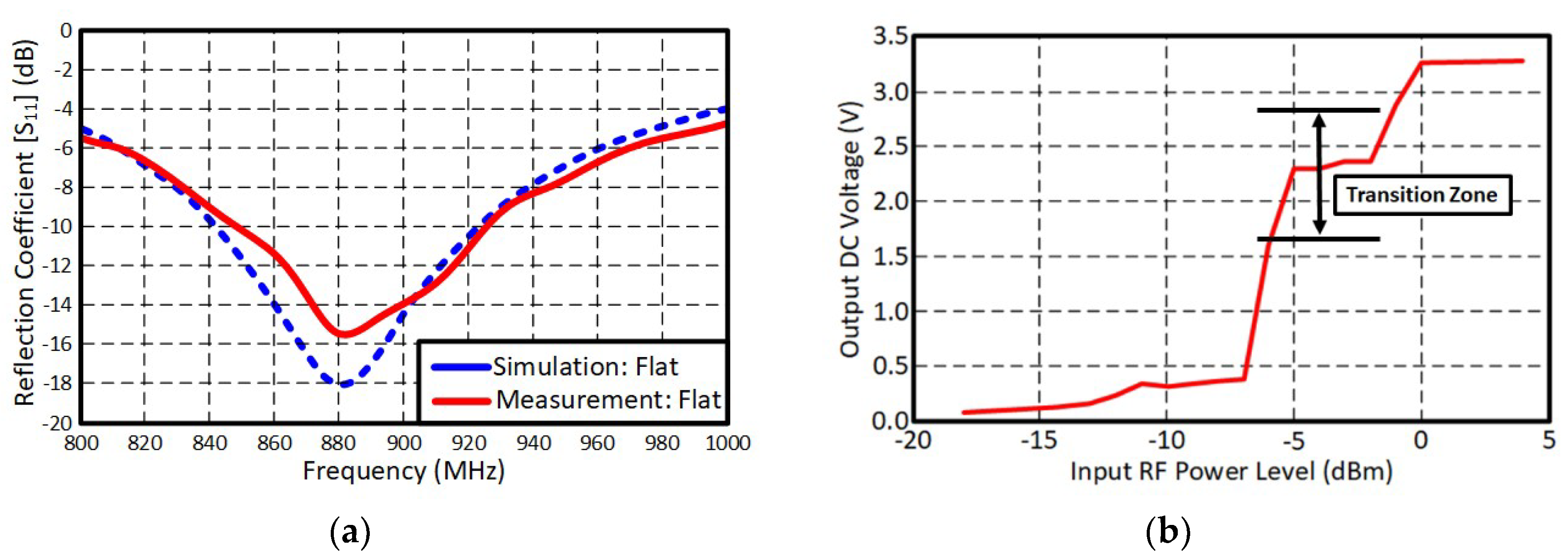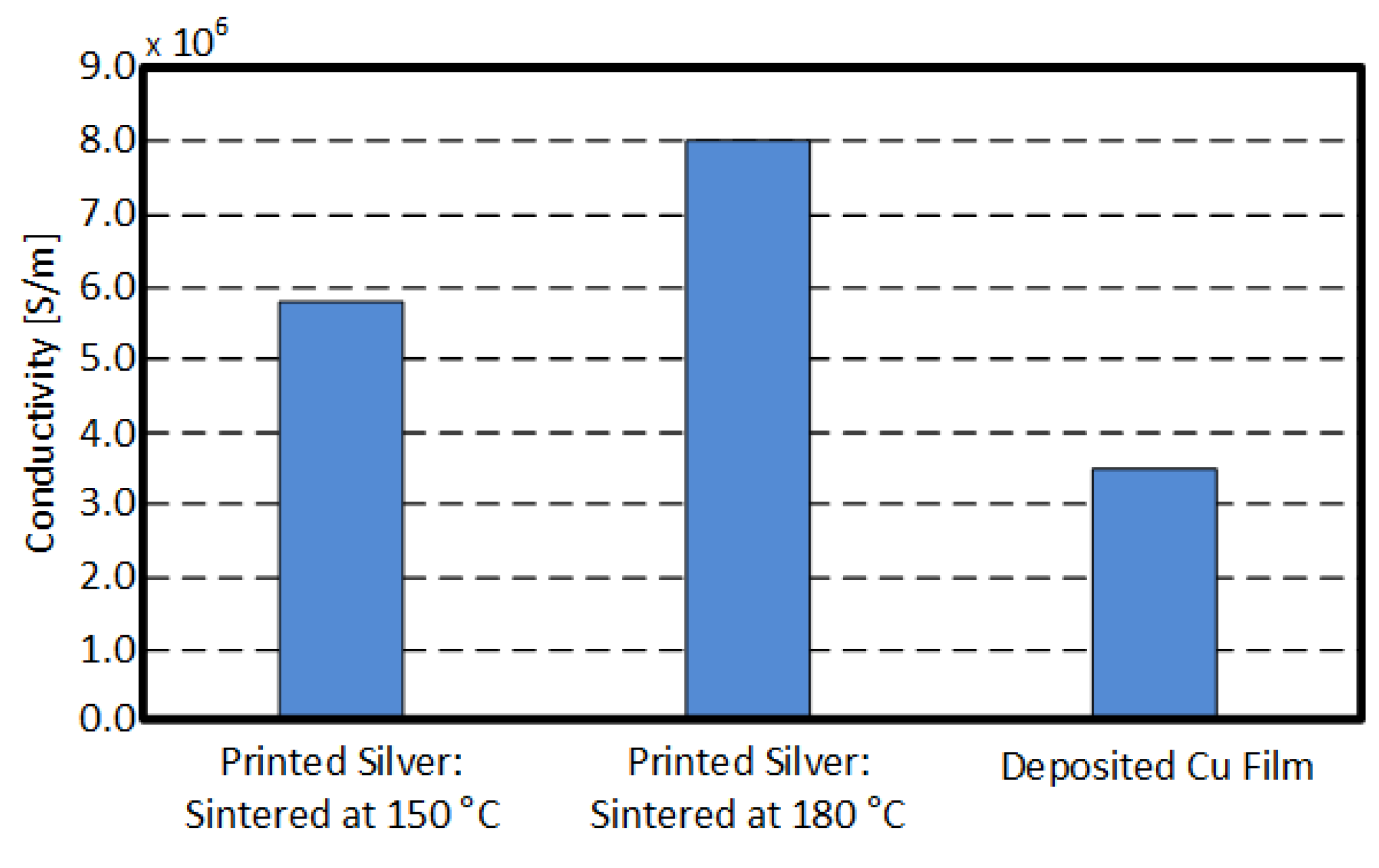Hybrid Printed Energy Harvesting Technology for Self-Sustainable Autonomous Sensor Application
Abstract
:1. Introduction
2. Hybrid Printed Electronic Technology for Autonomous Sensor Applications
2.1. Direct Silver Nano-Particle Printing: Wireless RF Power Supplier
2.2. Indirect Copper Film Printing: RF Energy Harvesting System for Autonomous Wireless Sensors
2.3. Direct Silver Nano-Particle Printing and Indirect Cssu Film Deposition
3. Conclusions
Author Contributions
Funding
Conflicts of Interest
References
- Kortuem, G.; Kawsar, F.; Sundramoorthy, V.; Fitton, D. Smart Objects as Building Blocks for the Internet of Things. IEEE Internet Comput. 2010, 14, 44–51. [Google Scholar] [CrossRef]
- Janhunen, J.; Mikhaylov, K.; Petäjäjärvi, J.; Sonkki, M. Wireless Energy Transfer Powered Wireless Sensor Node for Green IoT: Design, Implementation and Evaluation. Sensors 2019, 19, 90. [Google Scholar] [CrossRef] [PubMed]
- Kamalinejad, P.; Mahapatra, C.; Sheng, Z.; Mirabbasi, S.; Leung, V.C.M.; Guan, Y.L. Wireless Energy Harvesting for the Internet of Things. IEEE Commun. Mag. 2015, 53, 102–108. [Google Scholar] [CrossRef]
- Shafique, K.; Khwaja, B.A.; Khurram, M.D.; Sibtain, S.M.; Siddiqui, Y.; Mustaqim, M.; Chattha, H.T.; Yang, X. Energy Harvesting Using a Low-Cost Rectenna for Internet of Things (IoT) Applications. IEEE Access 2018, 6, 30932–30941. [Google Scholar] [CrossRef]
- Akan, O.B.; Cetinkaya, O.; Koca, C.; Ozger, M. Internet of Hybrid Energy Harvesting Things. IEEE Internet Things J. 2019, 5, 736–746. [Google Scholar] [CrossRef]
- Ando, B.; Baglio, S.; Bulsara, A.R.; Marletta, V.; Ferrari, V.; Ferrari, M. A Low-Cost Snap-Through-Buckling Inkjet-printed Device for Vibrational Energy Harvesting. IEEE Sens. J. 2015, 15, 3209–3220. [Google Scholar] [CrossRef]
- Sekitani, T.; Nakajima, H.; Maeda, H.; Fukushima, T.; Aida, T.; Hata, K.; Someya, T. Stretchable Active-matrix Organic Light-emitting Diode Display Using Printable Elastic Conductors. Nat. Mater. 2009, 8, 494–499. [Google Scholar] [CrossRef] [PubMed]
- Berggren, M.; Nilsson, D.; Robinson, N.D. Organic Materials for Printed Electronics. Nat. Mater. 2007, 6, 3–5. [Google Scholar] [CrossRef] [PubMed]
- Kim, S.; Georgiadis, A.; Collado, A.; Tentzeris, M.M. An Inkjet-printed Solar-powered Wireless beacon on Paper for Identification and Wireless Power Transmission Applications. IEEE Trans. Microw. Theory Tech. 2012, 60, 4178–4186. [Google Scholar] [CrossRef]
- Kim, S.; Jeong, S.; Bito, J.; Georgiadis, A.; Tentzeris, M.M. A flexible RF energy harvester using a hybrid printing technology for ‘stand-alone’ wireless sensor platforms. Flex. Print. Electron. 2018, 3, 015004. [Google Scholar] [CrossRef] [Green Version]
- Agate, S.; Joyce, M.; Lucia, L.; Pal, L. Cellulose and nanocellulose-based flexible-hybrid printed electronics and conductive composites—A review. Carbohyd. Polym. 2018, 198, 249–260. [Google Scholar]
- Zhao, A.; Tian, G.Y.; Zhang, J. IQ signal based RFID sensors for defect detection and characterization. Sens. Actuator A Phys. 2018, 269, 14–21. [Google Scholar] [CrossRef]
- Deng, F.; He, Y.; Li, B.; Song, Y.; We, X. Design of a slotted chipless RFID humidity sensor tag. Sens. Actuator B Chem. 2018, 264, 255–262. [Google Scholar] [CrossRef]
- Krikidis, I. Retrodirective Large Antenna Energy Beamforming in Backscatter Multi-User Networks. IEEE Trans. Wireless Commun. Lett. 2018, 7, 678–681. [Google Scholar] [CrossRef] [Green Version]
- Amato, F.; Peterson, C.W.; Degnan, B.P.; Durgin, G.D. Tunneling RFID tags for long-range and low-power microwave applications. IEEE J. Radio Freq. Identif. 2018, 2, 93–103. [Google Scholar] [CrossRef]
- DuPont Teijin Films. Available online: http://usa.dupontteijinfilms.com/ (accessed on 10 February 2019).
- Texas Instruments. Available online: http://www.ti.com/lit/ds/symlink/msp430l092.pdf (accessed on 10 February 2019).
- Ooi, Y.; Hanasaki, I.; Mizumura, D.; Mastuda, Y. Suppressing the Coffee-ring Effect of Colloidal Droplets by Dispersed Cellulose Nanofibers. Sci. Technol. Adv. Mater. 2017, 18, 317. [Google Scholar] [CrossRef] [PubMed]
- Patil, N.D.; Bange, P.G.; Bhardwaj, R.; Sharma, A. Effects of Substrate Heating and Wettability on Evaporation Dynamics and Deposition Patterns for a Sessile Water Droplet Containing Colloidal Particles. Langmuir 2016, 32, 11958–11972. [Google Scholar] [CrossRef] [PubMed] [Green Version]
- Gans, B.-J.; Schubert, U.S. Inkjet Printing of Well-Defined Polymer Dots and Arrays. Langmuir 2004, 20, 7789–7793. [Google Scholar] [CrossRef] [PubMed]










| Component | Value |
|---|---|
| Balun | 100 Ω:50 Ω (balanced:unbalanced) |
| Cmat | 4.7 pF |
| Ccp | 15 pF |
| Diode | SMS7630 (1) |
| DC-DC converter | TPS61073 (2) |
| Charge tank | 100 µF |
© 2019 by the authors. Licensee MDPI, Basel, Switzerland. This article is an open access article distributed under the terms and conditions of the Creative Commons Attribution (CC BY) license (http://creativecommons.org/licenses/by/4.0/).
Share and Cite
Kim, S.; Tentzeris, M.M.; Georgiadis, A. Hybrid Printed Energy Harvesting Technology for Self-Sustainable Autonomous Sensor Application. Sensors 2019, 19, 728. https://doi.org/10.3390/s19030728
Kim S, Tentzeris MM, Georgiadis A. Hybrid Printed Energy Harvesting Technology for Self-Sustainable Autonomous Sensor Application. Sensors. 2019; 19(3):728. https://doi.org/10.3390/s19030728
Chicago/Turabian StyleKim, Sangkil, Manos M. Tentzeris, and Apostolos Georgiadis. 2019. "Hybrid Printed Energy Harvesting Technology for Self-Sustainable Autonomous Sensor Application" Sensors 19, no. 3: 728. https://doi.org/10.3390/s19030728






